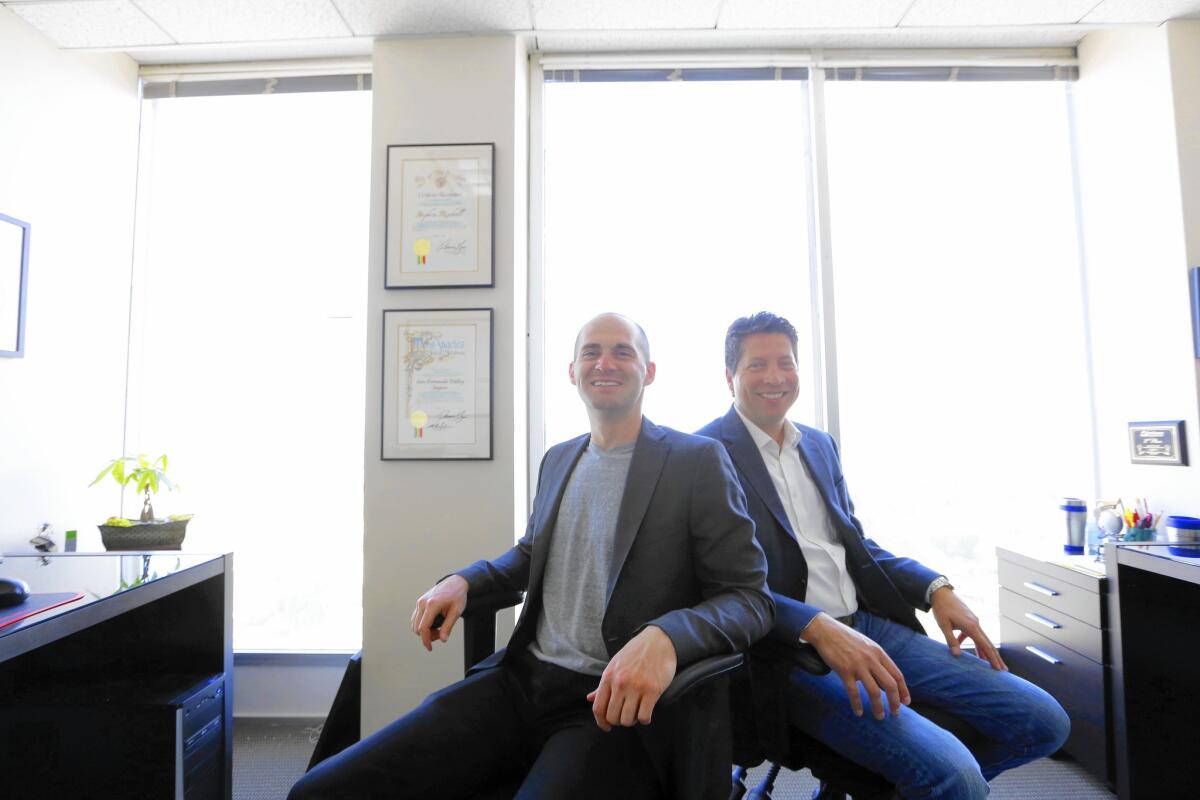More investors seeking financial advice are turning to lower-cost options

Stephen Rischall, left, and Matt Stadelman co-founded 1080 Financial Group, a small Sherman Oaks firm that promises to act in the best interest of the client.
Reporting from Washington â When John Rocca began earning enough money to start socking some away for retirement about 10 years ago, he took a time-honored approach to investing: hiring a broker from a large investment bank. But, like more and more Americans recently, he soon decided that approach to retirement investing wasnât working for him.
âI view a broker as theyâre working for a big firm and theyâre pushing products and they get paid commissions,â said Rocca, 46, a commercial real estate consultant from Burbank. âI felt like they were pushing the product rather than wanting to be a true advisor.â
------------
FOR THE RECORD
8:20 a.m.: An earlier version of this articleâs photo caption misspelled a 1080 Financial Group co-founderâs last name as Stableman. He is Matt Stadelman.
------------
So Rocca trusted his retirement planning and savings to 1080 Financial Group, a small Sherman Oaks firm that promises to act in the best interest of the client. Like other advisors who follow such a fiduciary standard, the firm charges a flat hourly fee or an annual percentage of the assets being managed instead of being paid commissions on the sale of mutual funds and other investments.
âTheyâre putting my interests first,â Rocca said.
His decision is emblematic of the dramatic changes reshaping the financial advice and management industry.
As baby boomers retire, younger Americans â particularly millennials â are questioning the conventional approach to retirement planning as their bank accounts grow big enough to start investing. Scarred by the 2008 financial crisis and suspicious of the motives of big Wall Street banks, investors of all ages are looking for lower-cost alternatives in the same sort of industry shake-up that has led increasing numbers of TV viewers to shun cable for online streaming.
The conventional sources of financial advice to the middle and upper-middle class â brokers such as those at Merrill Lynch, and wealth advisors working for big banks â are under pressure as more people shift to self-managed 401(k) plans, IRAs and other accounts that use low-fee stock and bond index funds. And younger investors especially are moving on to automated programs known as robo-advisors that spit out suggested portfolios and investment options.
From 2007 to â14, investors took a total of $659 billion out of actively managed U.S. stock mutual funds and pumped $1 trillion of new money into low-cost index domestic stock mutual funds and exchange-traded funds.
âThe investorâs got a lot more power than they ever did,â said John Anderson, managing director at SEI Investments Co., which provides services for financial advisors, âand the more power and the more choice they have, the better off they are.â
Demographics, technology and regulation are driving an industry shift that some warn could leave small investors unable to access the type of high-level financial advice offered to the wealthy by brokerage firms and big banks as those outfits focus on clients with at least $500,000 to invest.
Among the biggest change is a new federal regulation designed to prevent consumers from being steered toward IRAs and other retirement investments with higher fees or lower returns that benefit the advisors recommending or selling them.
Those conflicts of interest cost Americans $17 billion a year, according to the Obama administration.
The new rule from the Labor Department, which will be phased in over eight months beginning in April 2017, makes all retirement investment advisors into fiduciaries. That means they must put the clientâs best interests above their own.
The White House, which pushed hard for the rule against strong opposition from large financial firms and Republicans, said it would save a 45-year-old worker with $100,000 in retirement savings about $37,000 over the two decades before turning 65.
The rule prohibits what Barbara Roper, director of investor protection for the Consumer Federation of America, called a âtoxic web of financial incentivesâ for brokers, insurance agents and anyone else offering retirement investment services that often run counter to the consumerâs best interests.
But Republicans have called the rule âObamacare for your IRA and 401(k).â Theyâve joined large financial industry players in warning it will squeeze out services for average Americans by driving up costs for advisors.
Overall mutual fund fees have been dropping as consumers have become savvier about expenses and sought cheaper investment categories.
A poll by Fidelity found that three quarters of financial advisors expected to increase the cost of their services, with 62% planning to unload some smaller clients, because of the new fiduciary rule.
Stephen Rischall said he co-founded 1080 Financial Group last year because he wanted to get away from the pressure he was under as a broker to sell certain funds and other investment products to earn commissions.
âIf youâre trusting someone with your financial decision, they should have your best interest first,â Rischall said. âThey should disclose conflicts of interest and they should be transparent in pricing.â
The firmâs annual fees start at 1% of the assets being managed, with no minimum account.
âThatâs pretty darn affordable,â said Rischall, whose firm manages 190 accounts with more than $15 million in total assets.
Rischall, 29, said he wants to help young people get started investing, a tough task after the trauma of the 2008 financial crisis.
âThereâs a lot of distrust with millennials and the traditional financial market,â he said. âThey think the manâs out to screw them, unfortunately.â
Young investors are driving the push to take more control of managing their investments, in part because of confusion and concern over the fees they pay, said Mike Foy, director of the wealth management practice at market research firm J.D. Power.
âThere may be an element of it that relates to the financial crisis and a certain level of trust that has been lost in Wall Street that makes people less inclined to delegate managing their money to an advisor,â he said.
Study results released last month by J.D. Power found more investors â particularly millennials â were becoming âvalidatorsâ or people who âwant to make their own decisions but still have access to an advisor for support and as a sounding board.â
Wealthfront, a financial management start-up in Silicon Valley, is one of the companies trying to seize on the trend with robo-advisor services.
âWe see a lot of young people are really disgusted by the financial industry giving its best prices to the wealthiest people and the worst prices to people who are just starting out,â said Wealthfront Chief Executive Adam Nash.
âThey live in a world where Netflix can take on the cable companies, where Amazon can take on Wal-Mart,â he said. âIt doesnât make sense to them that that canât happen in financial services.â
Wealthfront offers personalized, automated management of investments with around-the-clock access on a computer or mobile device. Prices are low, with no advisory fee for investors with less than $10,000 in assets and an annual 0.25% fee on assets above that.
Clients answer questions about how much risk theyâre comfortable with, and the data are used to recommend a mix of stocks, bond funds and other investments. The investor then decides how much money to put into the account.
Only about 1% of assets from U.S. consumers will be invested using robo-advisor services this year, according to estimates by consulting firm A.T. Kearney. But that figure is expected to grow to 5.6% by 2020 as the technology goes mainstream.
Many financial planners are making more use of technology, said Pamela Sandy, president of the 24,000-member Financial Planning Assn. But she said robots canât take the place of human advisors, particularly if the stock market sustains a major tumble.
âI really question whether someone is going to stay committed to their long-term goals if we have another market correction ⌠and they have no one to talk to,â said Sandy, a Cleveland financial planner. âA robo cannot hold your hand.â
More to Read
Inside the business of entertainment
The Wide Shot brings you news, analysis and insights on everything from streaming wars to production â and what it all means for the future.
You may occasionally receive promotional content from the Los Angeles Times.











